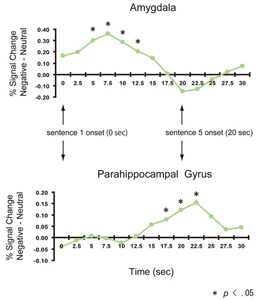Research Abstract
正負の感情がワーキングメモリー遂行を調節するのはどのような時か?
When do negative and positive emotions modulate working memory performance?
2013年3月5日 Scientific Reports 3 : 1375 doi: 10.1038/srep01375

本研究では、脳の活性化の視点から、どのような時に感情がワーキングメモリーを調節するのかを検討した。fMRIにより、感情的文脈を用いたリーディングスパンテスト(RST)のコード化および検索の段階において、脳活動を測定した。この感情RSTの参加者は、ネガティブ、ニュートラル、またはポジティブな感情的状態を引き起こす文章を読むことと同時に、文中のターゲット語を記憶することを求められた。ニュートラルRSTと比較して、ネガティブRST遂行時には、リーディング(コード化)段階に右の扁桃体が活性化した。海馬傍回でも有意な活性化が認められたが、それは扁桃体の活性化がニュートラルRSTと同程度になってからのことであった。これに対してポジティブRSTでは、ニュートラルRSTと比較して、リーディング段階に黒質が活性化した。こうした知見は、正負の感情が独自の神経回路によってワーキングメモリーを調節していることを示唆している。さらに、感情の調節とワーキングメモリーの容量との関わりに関しても考察した。
苧阪 満里子1, 矢追 健2, 源 健宏1 & 苧阪 直行2
- 大阪大学 大学院人間科学研究科
- 京都大学 大学院文学研究科
The present study investigated when emotion modulates working memory from the perspective of neural activation. Using fMRI, we measured brain activity during the encoding and retrieval phases of a reading span test (RST) that used emotional contexts. The emotional RST required participants to read sentences that elicited negative, neural or positive emotional states while they were memorizing target words from the sentences. Compared with the neutral RST, the negative RST activated the right amygdala during the reading phase. Significant activation was also found in the parahippocampal gyrus, albeit only after activation of the amygdala became comparable to that in the neutral RST. In contrast, the positive RST activated the substantia nigra during the reading phase relative to the neutral RST. These findings suggest that negative and positive emotions modulate working memory through distinctive neural circuits. We also discuss possible relationships between emotional modulation and working memory capacity.

